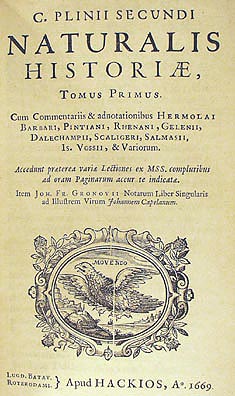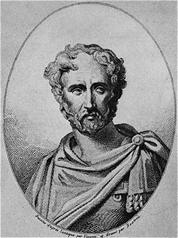Contenuto
- Text retrieval
- Dublin Core
- Information integration
- CIDOC CRM
- Thesauri
- SKOS
Dublin Core in RDF
Il text retrieval
- La
Naturalis Historia di Plinio il Vecchio
- In 37 libri
- Pubblicata nel 77 d.C.
- Il primo libro, pubblicato nel 79 d.C. dal nipote Plinio il Giovane, contiene il
sommario dei libri successivi ed un
elenco delle fonti per ciascun libro
-
I primi metadati?
In principio fu lo scriptorium…

stat rosa pristina nomine, nomina nuda tenemus
…poi venne Gutenberg…

(http://upload.wikimedia.org/wikipedia/commons/b/b0/Gutenberg_Bible.jpg)
…e infine i calcolatori
- Anni 1960: i grandi servizi di Information Retrieval
- organizzazione dei dati diversa
- interfacce diverse
- Anni 1970: Euronet Diane e il CCL
- un protocollo di comunicazione unico
- Common Command Language: un insieme definito e comune di campi informativi (AU, TI, …) e di comandi (FIND, SHOW,
…)
- Il protocollo Z39.50
- lavori iniziati negli anni 1970, con successive variazioni nel 1988, 1992, e 1995
- protocollo client-server
- il profilo
bib-1
- 1985:
Dublin Core
- 15 "Property"
- "qualifiers" (es. tipo e formato della data, vocabolario utilizzato)
Dublin Core Metadata Initiative
-
Uno dei primi vocabolari in RDF per metadati
-
Costituisce la base per i vocabolari per le
Digital Libraries distribuite
-
Dublin Core Metadata Element Set
-
15 categorie generali (elements) per
creare descrizioni semplici e facilmente
comprensibili per la maggior parte delle risorse
informative.
-
DCMES è solo elemento semantico di
base per i metadati sul Web
-
le singole comunità hanno spesso bisogno di
una semantica più ricca
-
altri metadati possono essere combinati
con DCMES
Il portale
Dublin Core
Dublin Core: la grammatica
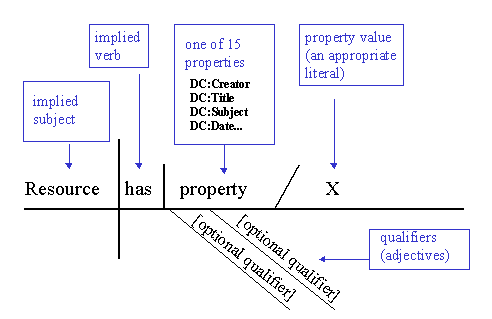
Dublin Core in RDF
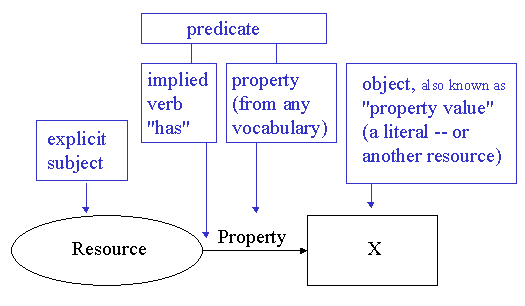
Dublin Core: due esempi
- Specifica del
tipo di data (revised) e del
formato (iso8601)
Resource has dcq:iso8601 dcq:revised dc:date '200-06-13'
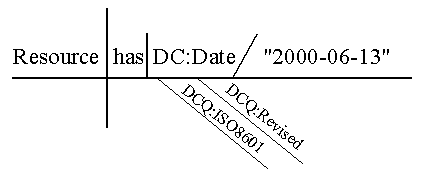
- Specifica del
vocabolario controllato utilizzato (Library of Congress Subject Headings)
Resource has dcq:lcsh dc:subject 'Languages -- Grammar'

Thesaurus vs ontology
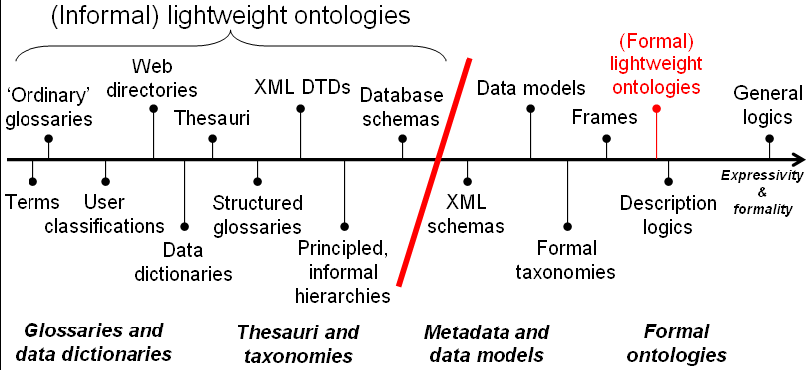
(from: Fausto Giunchiglia and Ilya Zaihrayeu: LIGHTWEIGHT
ONTOLOGIES - October 2007 -
Technical Report DIT-07-071)
Beware of false friends!
- Thesauri are often designed aiming to more
effective retrieval, instead of formally
representing the knowledge
- A thesaurus is not automatically an ontology
- Monumenti e siti archeologici
- Aree archeologiche
- Monumenti archeologici
- Parchi archeologici
- Siti archeologici
is a class with class-subclass
relationships
- Prima età moderna
is not a class, but an instance, and
cannot have sub-instances
-
Multiple inheritance and time dependent
relationships are also an issue
- See an example of temporal ontology and
inference
Faceted thesauri
Faceted thesauri are similar in many ways to faceted
classification systems. There are potentially
differences in the intended use, as discussed in Sect.
4. However there is scope for using both in
combination. Faceted thesauri can be used in both pre-
and post-coordinated systems and can underpin both
search and browsing applications.
Faceted thesauri belong to the family of KOS, which has
been used by the library community in modelling for
purposes associated with information retrieval
applications. They provide a semantic
structure at a suitable granularity for the general
problem of search and retrieval. In such
applications, where a fuzzy notion of
“aboutness“ is the basis for indexing
or classifying a document, as opposed to an
assertion of fact, the lightweight semantics of
faceted thesauri and related KOS may be more suited
than the formal semantics provided by AI
ontologies, designed for precisely modelling the
objects of interest in a domain. The SKOS standard
representation, combined with other developments in
standard identifiers and service protocols, now affords
the combination of formal syntax and informal
semantics, in Semantic Web applications and online
applications generally. This offers a cost
effective approach for annotation, search and browsing
oriented applications that don't require first order
logic.
(Douglas Tudhope & Ceri Binding: Faceted Thesauri,
Axiomathes (2008) 18:211–222 DOI DOI
10.1007/s10516-008-9031-6)
Limitations of existing KOS
-
Lack of conceptual abstraction
-
thesauri and other traditional KOS are collections
of terms (generic or domain-specific), ordered in
a polyhierarchic lattice structure or a monohierarchic
tree structure and interlinked with some very broad and
basic relationships. The distinction between a
concept (meaning) and its lexicalizations (words) is
not made consistently, if at all, in such a
system, and as such it does not reflect the ways humans
understand the world in terms of meaning and language
-
Limited semantic coverage
-
most thesauri do not differentiate concepts into types
or categories (such as living organism, substance, or
process) and have a very limited set of
relationships between concepts, distinguishing
only between hierarchical relationships, i.e. NT/BT,
and associative relationships, i.e. RT. These very
rudimentary relationships are not powerful
enough to guide a user in meaningful information
discovery on the Web or to support inference. They
do not reflect the conceptual relationships that
people know and that can be used by a system to
suggest concepts for expanding the query or making it
more specific.
-
Lack of consistency
-
since the relationships in thesauri lack
precise semantics, they are applied
inconsistently, both creating ambiguity in the
interpretation of the relationships and resulting in an
overall internal semantic structure that is
irregular and unpredictable. Many of the NT/BT
hierarchical relationships could, for example, be
resolved to the non-hierarchical RT relationship, and
vice versa
-
Limited automated processing
-
traditionally thesauri were designed for indexing
and query formulation by people and not for
automated processing. The ambiguous
semantics that characterizes many thesauri makes
them unsuitable for automated processing
Brian Vickery: A note on knowledge organisation,
[web]
[local]
SKOS
See other slides: [pdf] [ppt]
Conclusioni
- La rappresentazione della conoscenza è essenziale per una elaborazione automatica delle informazioni esistenti sul
web
- Le
tecnologie del Semantic Web (RDF, RDFS, OWL) consentono di
rappresentare,
esportare e
condividere la conoscenza in maniera interoperabile
- Molte iniziative nel settore biblioteche
(vedi ICCU - SBN in Linked Open Data) e beni culturali
